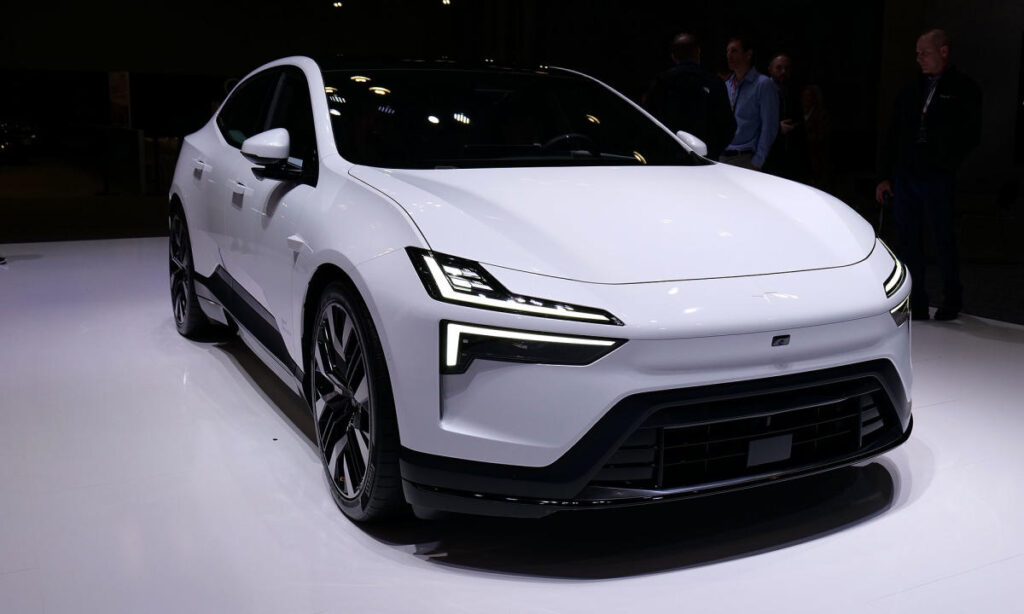Last year, Polestar announced the Polestar 4, its most practical electric car to date. But this week, during the car’s North American debut at the New York International Auto Show, we finally got an official launch price and a chance to peek at its most controversial feature.
Positioned as a slightly smaller and more affordable version of the Polestar 3, the company’s latest electric SUV looks to be Polestar’s most attractive mainstream offering yet, so that’s a big plus. The good news is that while it was originally said to cost around $60,000, the launch price is actually slightly less than that. The Polestar 4 standard remote single-motor version starts at $56,300 (including destination) and has a range of about 300 miles, while the dual-motor AWD version has a range of about 270 miles and costs $64,300.
Granted, that’s still significantly higher than many competitors, including the Tesla Model Y, which starts at $43,900 (before federal incentives), or the Hyundai Ioniq 5, which starts at $47,400. But after talking to Polestar CEO Thomas Ingenlath, I get the feeling the company agrees, as they see the Polestar 4 as a more approachable but still very premium offering among electric SUVs.
Visually, the Polestar 4 retains the dashing good looks we’ve seen on its larger sibling, but there are a few changes. Its nose is a bit pointier and more sloping, and it’s also less complex since it doesn’t have a front wing like the 3. The Polestar 4 is still based on the popular low-slung coupe-style SUV shape now. However, to ensure there’s plenty of room for rear-seat passengers, Polestar has ditched the rear window entirely, opting instead for a simple sheet metal, camera and rear-view mirror with an embedded monitor.
At first glance, this may seem like a step too far, even for an electric car that may not suffer from the same legacy burdens as a gas-powered car. But Ingenlath explains that this design change has many advantages. The lack of a rear window allows Polestar to create a spacious cabin by pushing the rear seats further back while maintaining plenty of headroom despite the sloping roofline. I had no trouble climbing in and out, and even with the front seats pushed as far back as possible, I still had plenty of legroom in the back. Also, unlike most cars, the Polestar 4’s rear seats recline, which adds to a casual feel.
Another major advantage is practicality. In fact, many coupe-SUVs have very small rear windows that don’t offer much useful visibility. And that’s before you consider any passengers or luggage that might further obscure your view. By replacing the rear window and mirrors with cameras and monitors, Polestar 4 can provide an unobstructed view of the rear of the car. But perhaps most importantly, the idea of a car without a rear window is not unheard of, as there are thousands of vans on the road today without rear windows.
So while the idea may still seem nerve-wracking, Inglas remains confident. He just asked customers to “try it.” He adds, “There’s a lot in psychology where people are instinctively opposed to change. But innovation is about asking what rules of the past don’t necessarily need to be rules of the future.”
The company’s Scandinavian heritage is reflected through the streamlined interior. Still, Ingenlath says the goal isn’t minimalism for minimalism’s sake. By using Soft Tech, a new fabric made from recycled plastic bottles, Polestar was able to line the cabin with a sustainable 3D material that lets in ambient light while still being extremely durable. The fixed glass roof on top is electrochromic and switches from transparent to opaque at the touch of a button.
One thing that strikes me is that, like all Polestar vehicles, the Polestar 4 feels like a designer car. Ingenrath, who built cars for Volkswagen, Audi and other companies before becoming Polestar CEO, said the company paid great attention to small details such as fonts and typography. You can see this in the text on the driver’s side door, which includes the car’s name and battery size, making for a label that’s both beautiful and informative. Additionally, there are features like ambient lighting, which uses naming standards based on the planets in the solar system (blue with a hint of green for Earth, red for Mars, etc.). “We just love what we’re doing, and we like to indulge in that passion,” Ingenlath said. “We had to find people who were equally passionate about this quality and technology.”
Unfortunately, we haven’t had the chance to take any of these 4 cars out for a spin. But as competition among electric vehicles continues to intensify, it’s clear that Polestar is carving out its own niche as a manufacturer that innovates through its vehicles. With pre-orders opening sometime in April and deliveries expected in the fourth quarter of 2024, it won’t be long before we get a chance to experience what the Polestar 4 will be like on the road.

2 Comments
Pingback: When no rear window makes for a better car – Tech Empire Solutions
Pingback: When no rear window makes for a better car – Paxton Willson